Holborn, Middlesex, London
Up to 1834
In 1723, part of the Middlesex portion of the parish of St Andrew Holborn Below the Bars became the parish of St George the Martyr.
In 1730, the other part of the Middlesex portion — the Liberty of Saffron Hill, Hatton Garden, Ely Rents & Ely Place — opened a workhouse on Little Saffron Hill. It was the subject of a report in the early workhouse directory, An Account of Several Workhouses...:
Another Workhouse is set up in St. Andrew's Parish, on Saffron-hill, it was opened October 14, 1730, and has now 46 Men, Women, and Children in it, belonging to the Liberty of Hatton-Garden, Saffron-Hill, and Ely-Rents, in Middlesex.
The Parish Officers of this Liberty have fitted up several old Houses for this use, and added a new Brick Building to them, the upper part of which serves for a Dining-Room, and the lower part for a Working-room, where they spin Candlewick, and by the Industry and Cleanliness of the Master and Mistress, the Poor here seem to be happily provided for.
The workhouse was located at the north end of Saffron Hill, near its junction with Ray Street, as shown on the 1790s map below:
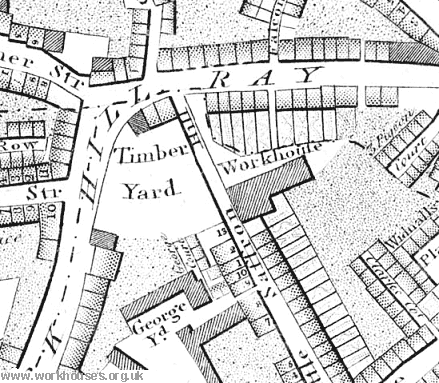
St Andrew's, Saffron Hill site, 1790s.
In the 1730s, St George the Martyr opened a workhouse on Little Gray's Inn Lane (now Mount Pleasant) which is shown on Rocque's 1746 map of London, Westminster, and Southwark.
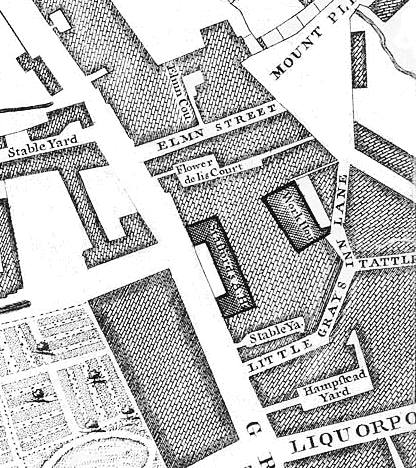
Holborn workhouse site, 1746.
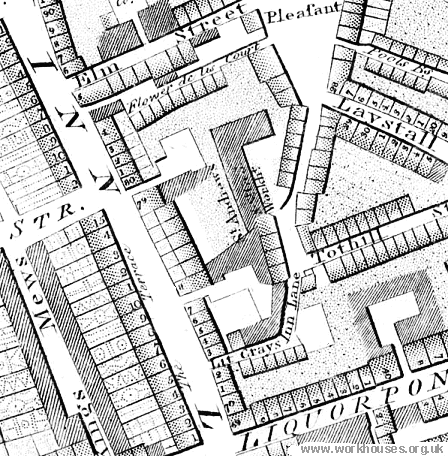
Holborn workhouse site, 1790s.
In 1767, the whole of the Middlesex portion of St Andrew Holborn joined to create St Andrew Holborn Above the Bars with St George the Martyr. In 1776, the Little Gray's Inn Lane workhouse could house up to 400 paupers. In 1813, the joint parishes erected a new building on the site, designed by Robert Leave.
After 1834
The Holborn Poor Law Union was formed on 27th April, 1836. Its operation was overseen by an elected Board of Guardians, 20 in number, representing its two original constituent parishes of St Andrew, Holborn above Bars united with St George the Martyr (14 Guardians) and the Liberty of Saffron Hill, Hatton Garden, Ely Rents and Ely Place (6 Guardians). The population falling within the union at the 1831 census had been 37,079 with an average (1833-35) poor-rate expenditure of £16,781 or 9s.1d. per head of the population. The parish of St Sepulchre was added to the union in 1845.
The Gray's Inn Road Workhouse
The Holborn Union took over Gray's Inn Lane (later Road) parish workhouse and in 1838, the Poor Law Commissioners authorized the sum of £9,000 for its enlargement. Its location is shown on the 1880s map below:
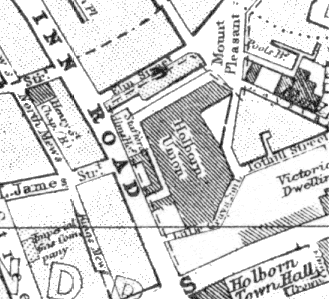
Holborn workhouse site.
In 1902, the Gray's Inn site was redeveloped as casual wards, with its entrance on Little Gray's Inn Lane (now Mount Pleasant). In 1912, the casual wards — in common with all those in London — were taken over by the Metropolitan Asylums Board. In 1923, it became 'The Hostel', where those genuinely seeking employment could reside in more amenable conditions than usually found in casual wards. From 1924 to 1929, between 1,000 and 2,500 such people were admitted each year.
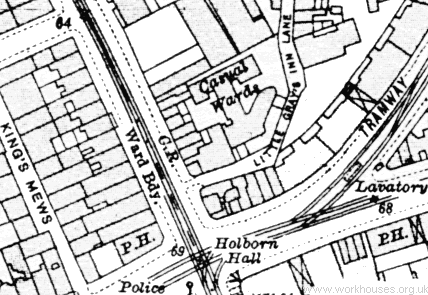
Little Gray's Inn Lane casual ward site, 1914.
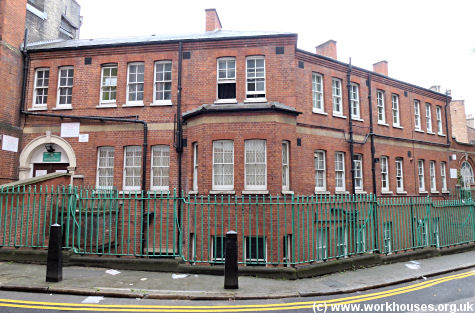
Little Gray's Inn Lane former casual ward, 2011.
© Peter Higginbotham.
The City Road Workhouse
In 1868, the recently formed Metropolitan Asylums Board set up six new Sick Asylum Districts for the purposes of providing hospital care for the poor on separate sites from workhouses. One of the new Districts, named Finsbury, comprised the Holborn Union together the parishes of St James & St John, Clerkenwell and St Luke, Middlesex. However, the large new hospital required by the new scheme was felt to be too expensive and, instead, the Finsbury Sick Asylum District was reconstituted as an enlarged Holborn Union.
The enlarged union redeployed its existing sites to provide the separate workhouse and hospital accommodation that was required. The former St Luke's workhouse on City Road was taken over by Holborn for use as a union hospital, with able-bodied inmates being catered for at the Gray's Inn workhouse. By the 1890s, the Gray's Inn site had become used solely to provide the union's casual wards.
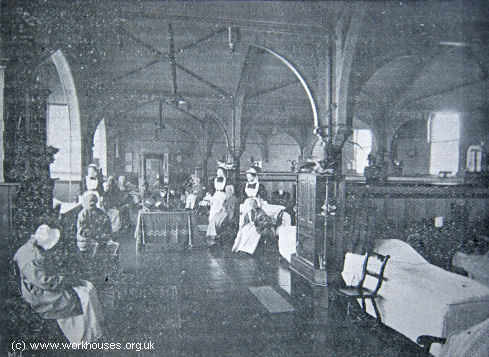
Holborn City Road workhouse sick ward, c.1905.
© Peter Higginbotham.
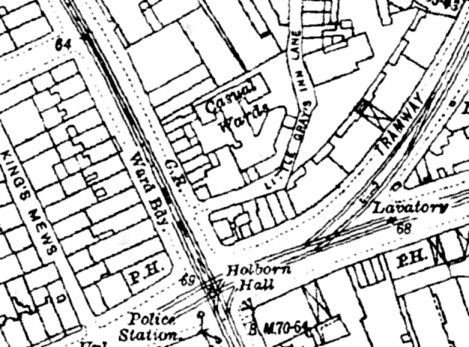
Holborn Gray's Inn casual wards, 1916.
In 1869-70, a shortage of accommodation forced the union to hire the old French Hospital in Bath Street, City Road, for use as a supplementary workhouse for up to 200 aged and infirm inmates.
As in many other workhouses, City Road occasionally hosted talks and concerts put on by visiting groups. In 1901, the "National Sunday League" put on a concert for the inmates which was captured in the following illustration:
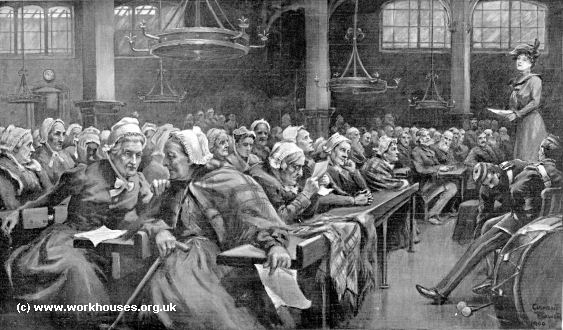
Holborn City Road workhouse Sunday concert, c.1901.
© Peter Higginbotham.
The Archway Road Infirmary, Highgate
In 1877-9, a new Union infirmary was erected at the west side of Archway Road, in Highgate. It was designed by Henry Saxon Snell, who was also responsible for a number of other London workhouse buildings around this time including the infirmaries for the St Marylebone and St Olave Unions. The infirmary location is shown on the 1913 map below:
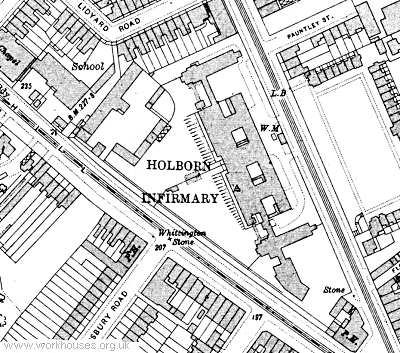
Holborn infirmary site, 1913.
Its unusual design had a central building where the wards had beds placed along internal partitions at right angles to the main walls. To the north and south of this block, linked by ground-floor corridors, were male and female 'Nightingale' pavilions where beds were placed in a long row along each side of the ward. A two-storey block at the east contained a dispensary, doctor's house, porter's quarters and receiving wards. The ground-floor layout is shown below. (Click on the image for an enlarged view.)
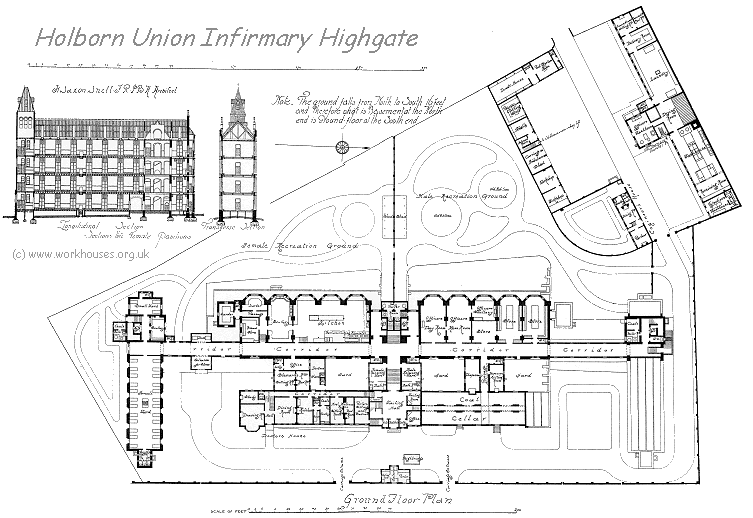
Holborn infirmary ground-floor plan, 1879.
© Peter Higginbotham.
HOLBORN UNION INFIRMARY, UPPER HOLLOWAY.
This building is situated nearly at the junction of Highgate-hill and Archway-road, immediately in the rear of the Archway Tavern, Upper Holloway. The ground along the whole frontage falls from north to south 23 ft., and it is, therefore, somewhat difficult to show clearly by a plan the mode in which the various departments are connected, for that which is the ground floor at the upper part of the site becomes, under the circumstances, the first floor at the lower portion. The front entrance building is also necessarily at a different level from that of the hospital proper, and consequently, in order to reach the corridor, which connects the various blocks of sick wards, it is necessary to descend by a flight of steps some feet below the level of the entrance.
The chief point of interest in the arrangement of this building is, however, the planning of the sick wards, as it introduces in hospital construction a new method of arranging the beds and windows. This arrangement has been adopted by the same architect in wards erected at two London workhouses for the reception of aged and infirm paupers, and the guardians of the Holborn Union were so well pleased with these wards that they determined to build their infirmary wholly on the same plan. This, however, was objected to by the Local Government' Board, who insisted upon the erection of wards designed upon the pavilion principle. After much contention, however, a compromise was effected, and the buildings have consequently been erected half on the one plan and half on the other. This result will, perhaps, be beneficial, as the two systems can be tried side by side.
In our issue of the 11th of January last we gave a description of the Infirm wards of St. Luke's workhouse, and as those of the central portion of the building now under consideration are very similar, it will be unnecessary to recapitulate their details. It will, however, be seen that being for sick inmates, a larger cubic space per patient has been requisite, and consequently the wards are somewhat larger, and the distance apart of the beds is also greater. The positions of the water-closets and bathrooms are likewise more easy of access to the sick inmates of the wards, being situated in towers at either end, but cut off from the immediate proximity of the wards by cross ventilated lobbies.
The shape of the pavilion wards is similar to that of those in all other hospitals lately erected, but some novelties of construction have been introduced. The windows are made as casements nearly reaching the floor-level, and they open in such manner that the patients lying in bed may be protected from draught.
>
These casements are so constructed as to render them when shut more nearly airtight than the ordinary lifting sashes ; but in order to meet the opinion of those who prefer the lifting sashes, the architect has contrived that the upper part of the window shall open in this fashion, and so be used for additional ventilation whenever the weather will so permit. The fire-grates that stand in the centres of these wards are also of novel construction. They consist of an open fire at front and back, and the flues from them descend and pass right and left under the floors to the outer walls, in which they are continued to the chimney-shafts above the roof. The novelty of their construction, however, consists in the sides, back, and top of the fires being surrounded by a wrought-iron casing containing water, and that at the sides of the stove there are two upright coils of pipes through which this water when heated by the fire, circulates. Thus the whole of the products of combustion are utilised for heating purposes, and it will be seen that as the water cannot attain a temperature higher than 212° Fah. the iron over which the fire passes cannot, as is the case with ordinary air body stoves, be so heated as to burn the air impinging against its surface. Another advantage offered by this plan of heating is that a vase on the top of the stove contains the water rising from the lower part when it is expanded by the heat of the fire, and that this water being warmed a slight vapour arises from the vase, which serves to moisten the air of the wards. It should not be forgotten also to add that a channel runs under the floor to each side wall, and communicates with the outer air, thus forming a passage for fresh air to pass from the outside round the stove and the heated coils of pipes into the room. Stoves with descending flues are generally found to "smoke" when the flues get cold through the fires being neglected, or from their being let out during the night, but this difficulty has been successfully combated by encasing the horizontal iron flue-pipe in sand as it passes through the floor. The sand retains the heat of the flue for many hours, and it is only once, therefore, if at all, and then at the beginning of the winter, that the flue will require "piloting." These grates are manufactured by Messrs. Potter & Sons, of 298, Oxford-street.
The ventilation of the wards is effected by purely natural means, and is dependent, therefore, upon the simple and well-known fact that (ceteris paribus) heated air will always rise to a point higher than that of the colder air surrounding it, and that in its passage it will carry with it deleterious gases which would otherwise, by reason of their greater density, remain stationary or descend to the floor level.
At the back of the beds there are skirting-boxes with panelled fronts, the panels immediately under the heads of the beds being formed of perforated zinc ; and running through these boxes are 4-in. hot-water heating-pipes, which go the whole length of the wards. There are openings in the wall partially covered with perforated doors for the admission of fresh air from the outside, and this air, passing over the hot-water pipes and becoming warm, will be emitted into the room through the perforated fronts of the skirting-boxes and immediately under the head of each bed.
The ceilings over each pair of beds have perforated zinc panels running the whole width of the wards, and covering a channel the full depth (12 in.) of the floor; each of these channels communicates with a large shaft running up the wall like an ordinary chimney-flue. Now, returning to the skirting box, it will be obvious that the greater part of the warmed fresh air will pass into the room through its perforated front, immediately under the heads of the beds, and this air will be drawn upwards, and, passing through the perforated zinc of the coiling channels, be conveyed by the upright flues and find its exit at their terminations, but it is obvious also that the air in thus passing upwards from the skirting-box to the ceiling would encircle, as it were, the space surrounding the head of the sick patient, and carry with it his emanations, and, therefore, each pair of beds is provided with its own separate system of ventilation, whilst the general ventilation of the wards is supplemented by the central stoves previously described, and by the twelve upcast shafts in the side walls.
The buildings are connected by a corridor, 10 ft. wide, and on either side of this corridor are the kitchens, lifts, store-rooms, and other administrative offices. In the centre is a narrow tramway running the full length, and thus connecting all parts with the lifts that are situated. at the bottom of the staircases loading to the various blocks of wards. The laundry, mortuary, coach-house, and like offices, are all detached from the main buildings.
The total accommodation for sick patients is 624. The cost, inclusive of all engineering works, boundary-walls, and fittings and fixtures of every description, we are informed, will not exceed 80,0001. Messrs. John Mowlem & Co. are the builders. The heating and engineering works, cooking apparatus, lifts, sanitary, and gas fittings, have been executed by Messrs. Benham & Sons, Messrs. May, Bros., Messrs. Potter & Sons, Messrs. deal, Bros., Messrs. Richardson & Ellson, and Mr. E. Howard. The blinds are being executed by Messrs. Janes & Sons. The architect is Mr. H. Saxon Snell.
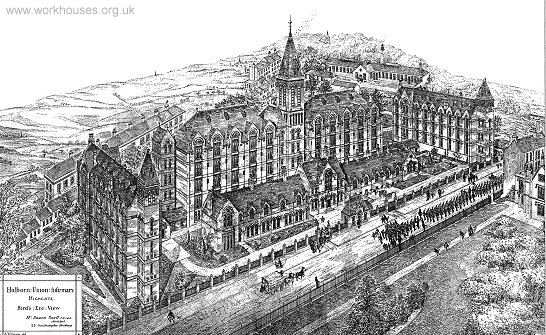
Holborn infirmary from the east, 1879.
© Peter Higginbotham.
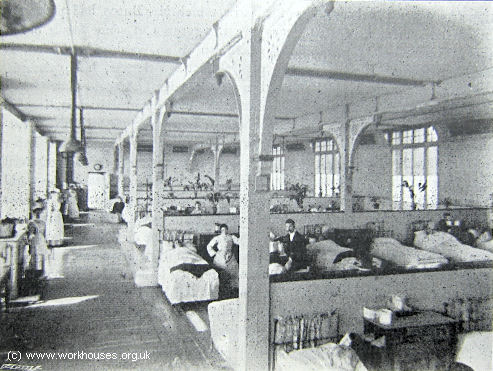
Holborn new-style infirmary ward, 1896.
© Peter Higginbotham.
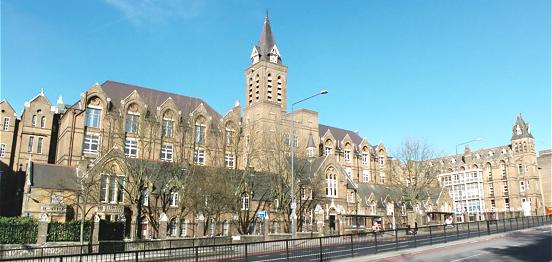
Holborn infirmary from the east, 2003.
© Peter Higginbotham.
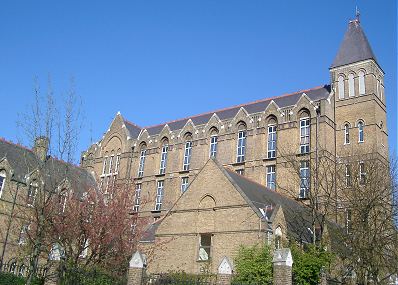
Holborn infirmary from the south, 2003.
© Peter Higginbotham.
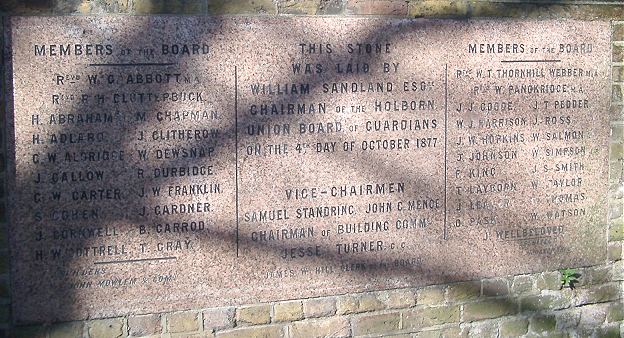
Holborn infirmary foundation stone, 2003.
© Peter Higginbotham.
The infirmary later became Archway Hospital and then from 1948 as Whittington Hospital, Archway Wing. In 1998, the buildings were acquired the University of Middlesex and University College, London. From 1999 to 2013, the site operated as a medical research and education facility known as the Archway Campus. It was then sold for redevelopment to the Peabody Trust but in 2022 was still standing empty.
The Mitcham Industrial School
In 1870, Holborn purchased a large industrial school at Mitcham formerly run by the parish of St George the Martyr, Southwark which had been absorbed by St Saviour's Union the previous year. The school, erected in 1856, stood in the grounds of an old wainscotted mansion called Eagle House at the west side of the High Street in Upper Mitcham.
Eagle House itself accommodated fifty boys aged seven to nine, and six monitors selected from the older boys.
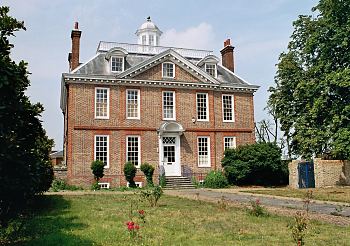
Eagle House, Mitcham, 2004.
© Peter Higginbotham.
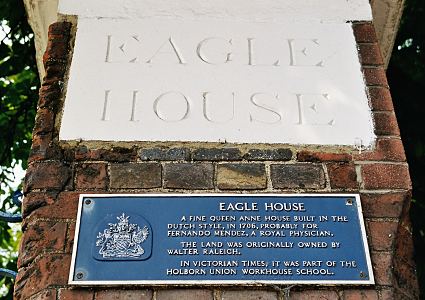
Mitcham School entrance, 2004.
© Peter Higginbotham.
The main school building had an E-shaped layout typical of the "barrack" school establishments of the period such as those at Hanwell and Anerley. It had an Italianate-style administrative centre with an imposing tower above. To each side were three-storey wings, one for boys and one for girls. A lodge gate and garden faced onto the road at the east.
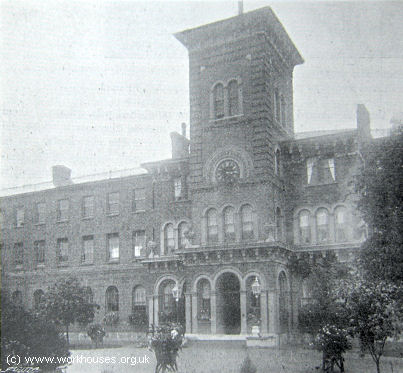
Mitcham School main building from the east, 1896.
© Peter Higginbotham.
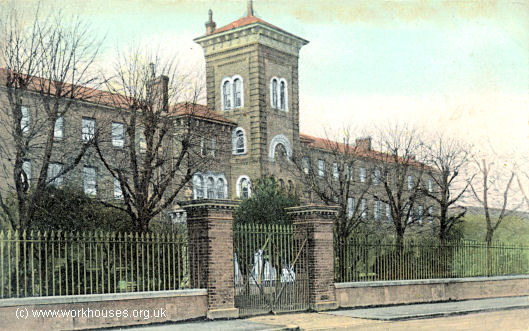
Mitcham School main building from the south-east, c.1910.
© Peter Higginbotham.
At the rear of the main block was the infants' building which could house about 70 under-sevens. A nearby day nursery accommodated up to 10 babies. The infirmary, at the west of the site, was a large three-storey building. In 1896, the average number of patients was 33. During that year there were outbreaks of scarlet fever, whooping cough and measles, the latter being responsible for six deaths. Ophthalmia, which was often rife in workhouse schools, was represented by only four cases at the end of the year.
A probationary lodge (south-west of main block?) could accommodate 30 children who stayed there for up to three weeks. In 1896 a teacher was appointed specially to teach those in the infirmary and probationary lodge.
The school's layout is shown on the 1913 map below.
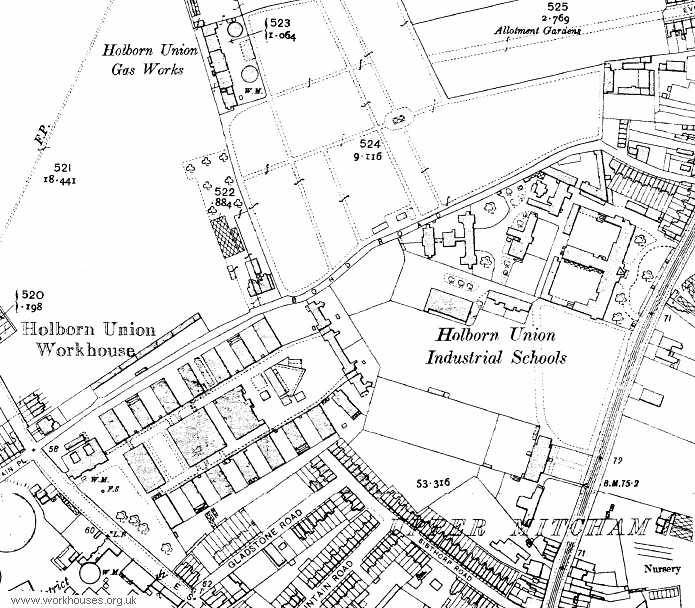
Holborn Mitcham site, 1913.
© Peter Higginbotham.
The school classroom block lay immediately to the south of Eagle House. The T-shaped building had boys' classrooms on the ground floor and girls' on the first floor.
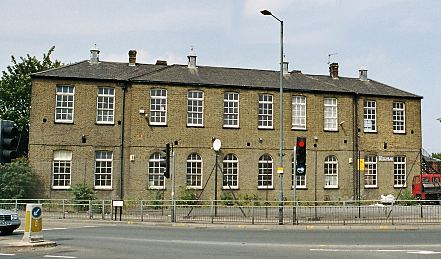
Mitcham School classroom building, 2004.
© Peter Higginbotham.
A variety of industrial training took place in the school. The baker's department had eight boys in training and provided bread for both the school and the adjoining workhouse. Six boys worked in the carpenter's shop and helped keep the school's buildings and furniture in good repair. The school's own farm provided all the milk and some of the meat and vegetables consumed by the school. Twelve boys were employed in the gardens' cow-sheds and stables. A tailor's shop employed six boys and produced much of the boys' clothing in the school. The shoemaker's shop produced boys' and girls' boots. An engineer's shop employed four boys.
Training for the girls included sewing and dressmaking. In 1896, a daily average of around twenty girls produced 8,887 articles of new clothing and repaired 9,137 others. Training in household skills included scrubbing, cleaning and cooking. It was said that the supply of servant girls from the schools was not enough to meet the demand.
The school had its own indoor swimming pool, and the school band offered a route into the army for some boys. The school also sent boys to the Exmouth naval training ship run by the Metropolitan Asylums Board.
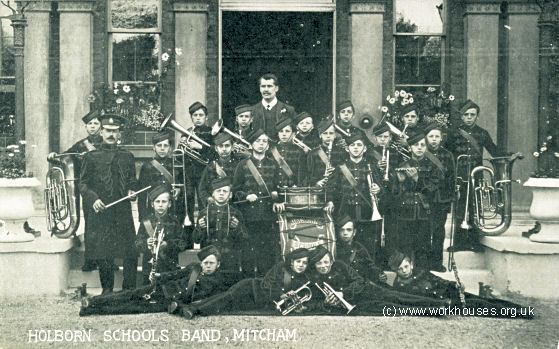
Holborn Schools Band, c.1902.
© Peter Higginbotham.
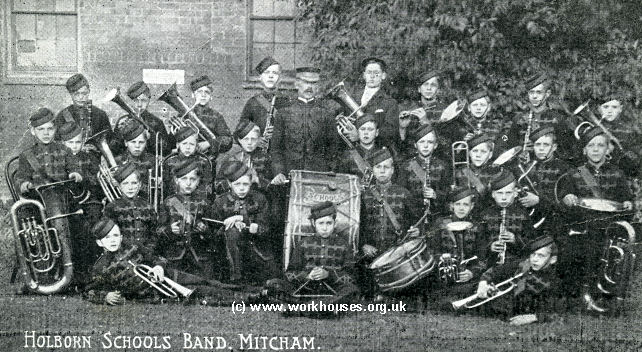
Holborn Schools Band, c.1905.
© Peter Higginbotham.
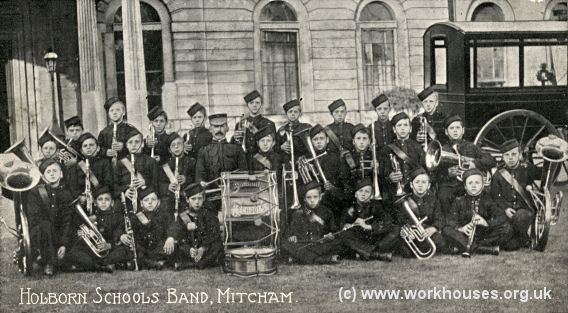
Holborn Schools Band, c.1906.
© Peter Higginbotham.
A recreation room was provided in the main block and was used by boys and girls on alternate evenings. Entertainments provided for the children included dancing, singing, magic lantern shows, band of hope meetings, attending outside cricket and football matches, and occasional picnics and excursions. Children were also allowed to visit near relations during the holidays. In 1896, forty boys who had gained badges for good conduct were allowed to take walks by themselves on Sunday afternoons. Some of the older girls were allowed to attend evening services at the neighbouring church. The school did not have its own chapel, although the large dining-hall at the rear of the main block was used to hold some services.
In August, 1917, Charles Vogel — then aged 4 years and 9 months — entered the Mitcham Schools, where he was to stay until February 1929. He trained as a baker and played in the band. Charles' son, Brian Vogel, has kindly contributed some photographs taken during this period, together with a programme for the 1928 prize-giving ceremony.
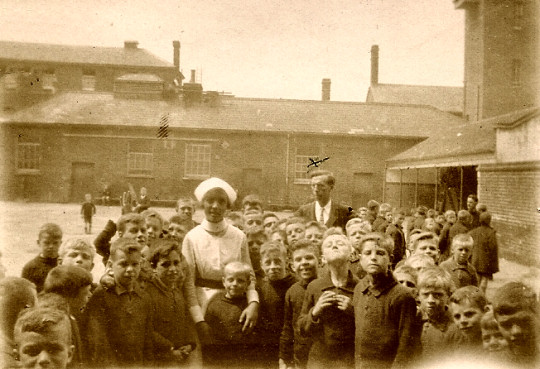
Holborn Schools 1920s, courtesy of Brian Vogel.
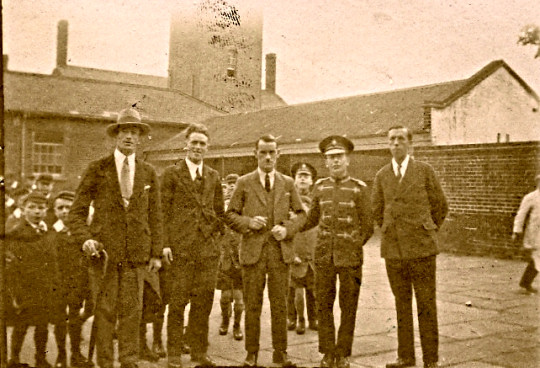
Holborn Schools 1920s, bandmaster Mr Butterworth at right, courtesy of Brian Vogel.
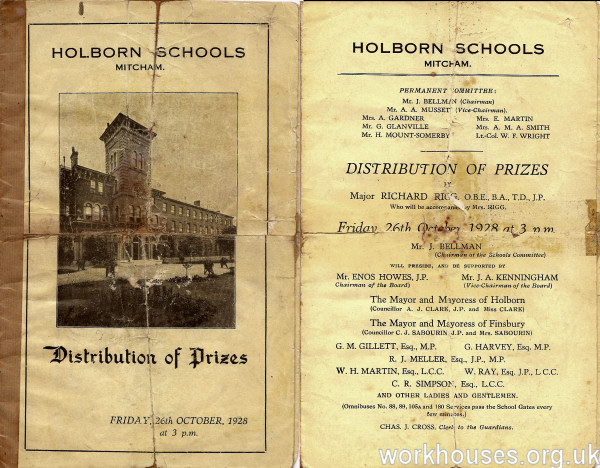
Holborn Schools prize-giving programme, 1928, courtesy of Brian Vogel.
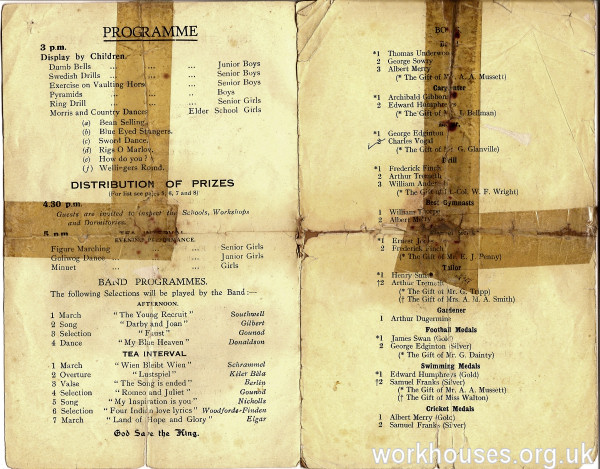
Holborn Schools prize-giving programme, 1928, courtesy of Brian Vogel.
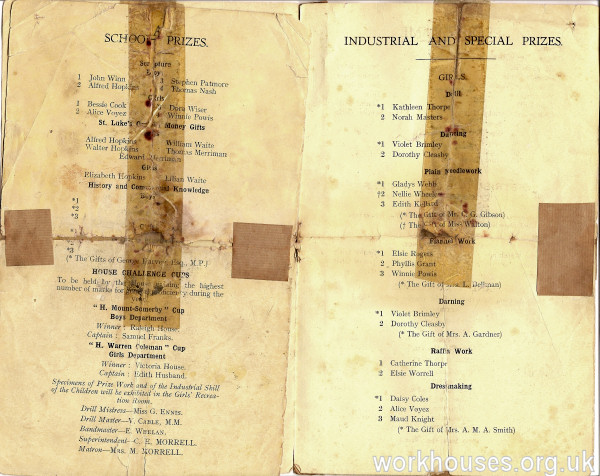
Holborn Schools prize-giving programme, 1928, courtesy of Brian Vogel.
During this period, boys from the School were taken on an annual holiday to 'The Retreat' at Dovercourt, near Harwich. The property can be seen in the background, right of centre, in first picture below.
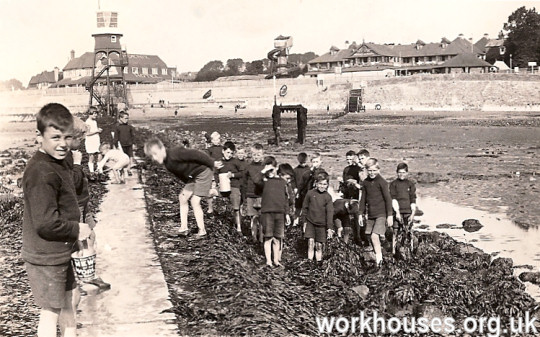
Holborn Schools at Dovercourt, 1920s, courtesy of Brian Vogel.
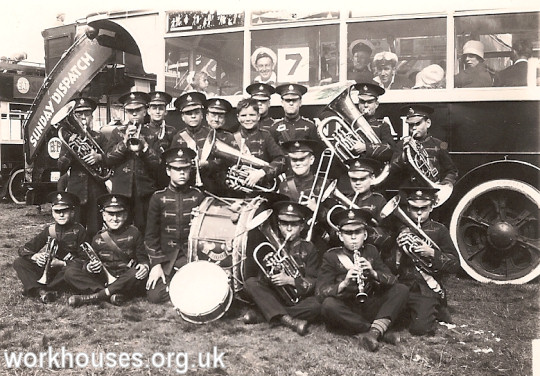
Holborn Schools at Dovercourt, 1920s, courtesy of Brian Vogel.
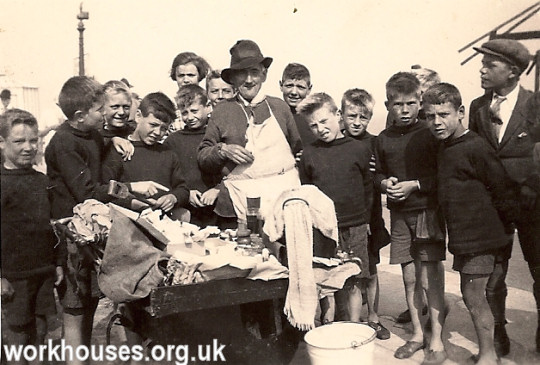
Holborn Schools at Dovercourt, 1920s, courtesy of Brian Vogel.
The main Mitcham Schools buildings no longer exist, although Eagle House and the classroom block survive.
The Mitcham Workhouse
On 14th April, 1885, the Holborn Guardians' Chairman Mr Benjamin Garrod laid foundation stone for a new workhouse at a site on Western Road, Mitcham, adjacent to the Industrial School. The building, which was to accommodate up to 1,000 inmates, was opened in October of the following year. The architects for the scheme were Henry Saxon Snell and his son Alfred. Their design was based on the pavilion principle with a row of separate detached blocks for each sex placed either side of a row of administrative and service buildings. Details of the project were given in a report in the magazine The Builder:
WORKHOUSE FOR ABLE-BODIED POOR OF THE HOLBORN UNION
The Workhouse buildings were designed, and their erection superintended, by the Guardians' architects, Messrs. H. Saxon Snell & Son. The builders were Messrs. Wall Brothers, and their estimate was accepted as being the lowest of the eight tenders sent in competition for the erection of the buildings.
The greater part of the engineering works of the Union Buildings, as the heating, cooking, and laundry apparatus, has been executed after competition with other firms by Messrs. May Brothers; the gas-pipes and fittings have been in like manner executed by Messrs. Berry & Sons, and the various sanitary and other apparatus have been supplied by Messrs. Bolding & Sons, Wilcock & Co., Doulton & Co., Bradford & Co., Macfarlane & Co., Bacon & Co., Hawke & Son, and Thomas Elsley. The wood block flooring has been laid by Mr. Roger Lowe, and the pavings of yards and outside corridors by Mr. Alfred Walker, of Leeds.
General Arrangement.—As will be seen, the general arrangement of the buildings is upon what is known as the "block system," each department being a detached and separate building, connected to the others only by open covered ways. Many hospitals and infirmaries have been erected upon this system of late years, but it is believed that this is the first attempt to apply the principle in its entirety to a workhouse.
The establishment is approached from Merton-lane through two gateways,—the one for carts, which gives access to a road that encircles the whole of the various blocks of buildings, and the other for foot passengers, who at once enter the receiving-house, containing the porter's office and residence, and a waiting-room, also probationary wards for the temporary accommodation,—pending their admission into the body of the house,—of twelve inmates of each sex (twenty-four in all). Bath-rooms and clothing-stores are also provided here, together with arrangements for disinfecting and washing all personal clothing, before being admitted into the house. In the rear of this block is a dead house and post-mortem room. Passing through and out of this receiving-house, a covered way is entered, which leads to the various blocks of building situated on either side of it.
On the left are four three-storied buildings, each fitted for the reception of 112 male pauper inmates (448 in all), and between each of these blocks, one-storied buildings are provided for use as workrooms, whilst the intervening spaces form enclosed airing-yards.
The central one-storied building is reserved for workshops, such as wood-cutting, stone-breaking, and oakum-picking ; but this has not yet been erected, as it is uncertain, until the establishment has been brought into use, what description of labour will be most remunerative in this locality.
The covered corridor terminates at the furthest of the block of buildings just described, but it is continued onwards by a raised and paved pathway leading to the Infirmary, —an entirely detached building, planned for the reception of thirty inmates of each sex (sixty in all).
Passing through to the opposite end of the infirmary building, a pathway and covered corridor similar to that last described returns and gives access in like manner to four three storied buildings, each providing accommodation for 112 pauper (but in this case female) inmates. Work-rooms and airing-yards, corresponding to those on the opposite side, are also provided, but the central one-storied block is designed for the use of twelve married couples. Between this outer ring of buildings, and separated from them by the encircling cart. road, are five blocks of buildings. The one facing Merton-lane contains the principal offices, viz., the Board and committee room, the master's and matron's and the assistant-master's and matron's residences, and also the dispensary. In the rear of this building is a recreation-ground, with tennis-lawn for the use of the officers ; and beyond it a block containing the dining-hall, kitchen, and general store-room. Then a roadway intervenes, and on the other side is a building containing the laundry and washhouse, with coal-stores, engineers' shops, and furnace-rooms. At each angle of the rear potion of this building is a bath-room for the use of the officers. On the opposite side of the roadway, running past the back of this building, there is a water-tower, on the upper part of which is placed the tank through which the whole of the water for the supply of the various buildings passes. The basement story of this tower is fitted with two cells for the temporary detention of refractory inmates. Between this tower and the infirmary there is a large space of ground, upon the central portion of which it was intended to erect a chapel; but the Guardians have determined (at any rate for the present) to make use of the dining-ball for this purpose. Of this hall an interior view is subjoined.
Cost.—The total cost of the buildings, including fittings, laying-out grounds, boundary walls, and drainage, also professional fees and clerk of works' salary, is estimated at 66l. per inmate.
Heating.—The receiving- house, officers' and day rooms, married couples' quarters, and the front administrative offices are warmed by means of open fires; the work-rooms by Musgrave's slow combustion stoves, and the dormitories generally are heated by means of hot-water pipes which run round the side walls next the floors. These pipes are all heated from the furnaces near the engine-house, and these furnaces also provide steam for the heating pipes in the dining-hall, which are carried across and beneath the floor in an open trench covered with gratings; they also traverse the two side walls above the floor line.
Gas.—Works are in course of erection on adjoining ground for the manufacture of the gas required for the use of the new workhouse, and also for the adjacent schools. The gas will not only be used for lighting the buildings, but also for heating the laundry closets, the disinfecting chambers, and refractory cells. It will also be required for the Otto gas engines of the laundry and of the water-softening apparatus. The mains are, however, as a matter of precaution, connected with those of the Local Gas Company.
Water Supply.—All the water for use in the building will be supplied from an artesian well in the adjoining school grounds, but before reaching the buildings it will be passed through a patent water-softening apparatus now being erected by Messrs. Atkins & Co. It is anticipated that by the use of this apparatus a great saving will be effected in the quantity of soap and soda used in the establishment. The softened water will be pumped into a tank situated on the upper part of the tower in the rear of the laundry block, and from thence it will descend by cast-iron pipes for the supply of the various cisterns in the lower parts of the buildings. The sinks, baths, and lavatories throughout the building are supplied by hot water heated by steam pipes running from the furnace-room in the rear of the washhouse and laundry.
Drainage.—The drainage of the buildings is effected by means of two deep drains carried beneath the roads running down either side of the central administrative blocks, and cross drains run into those from between the yards and roads separating the various blocks of buildings. Both of these main drains converge under the lawn in front of the building, where there is a ventilated manhole, and a syphon-trap for cutting off any foul gases from the sewer that runs down Merton-lane. There are, however, additional ventilated manholes at other important connexions with the cross drains, and many inspection pits fitted with air-tight covers. At the head of the southern axis drain next to the boundary-wall in the rear of the infirmary, a large tank fitted with Doulton's flushing apparatus is provided for periodically cleansing this length of pipe. The main drain beneath the northern road receives all the drainage from the schools, and this is occasionally flushed by the letting off of the water from the swimming-bath of that establishment The rain-water is conveyed away by a separate system of drains. All drains are stoneware, and those of the two main drains are "Boulnois" patent pipes, 9 in. and 12 in. diameter The other pipes are ordinary socket-pipe generally 6 in. diameter. All rain-water pipes and bath and sink wastes, discharge over grated gullies, especially made with angle outlets by Messrs. Bacon & Co.
The workhouse site layout is shown in the 1913 map included above. The architects produced a "bird's-eye view" of their proposed design:
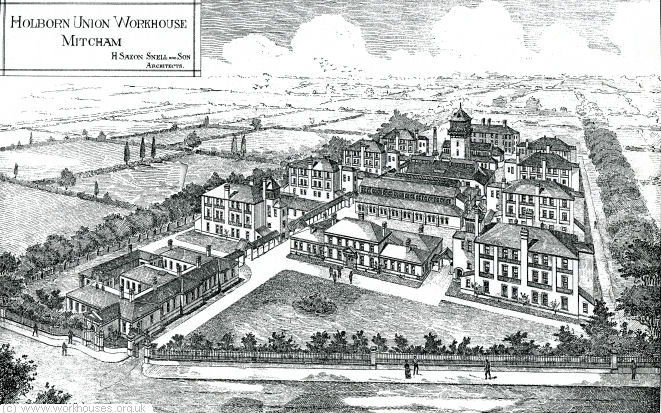
Holborn bird's-eye view from the south-west, 1885.
The opening of the new workhouse in October, 1886, was recorded by The Times:
The main entrance to the site was at the west where a lodge and casual wards were situated. At the centre, progressing from west to east, were the administrative block and board room, dining-hall and kitchens, laundry, and chapel. Male blocks were to the north and female to the south. A covered walkway ran between all the blocks.
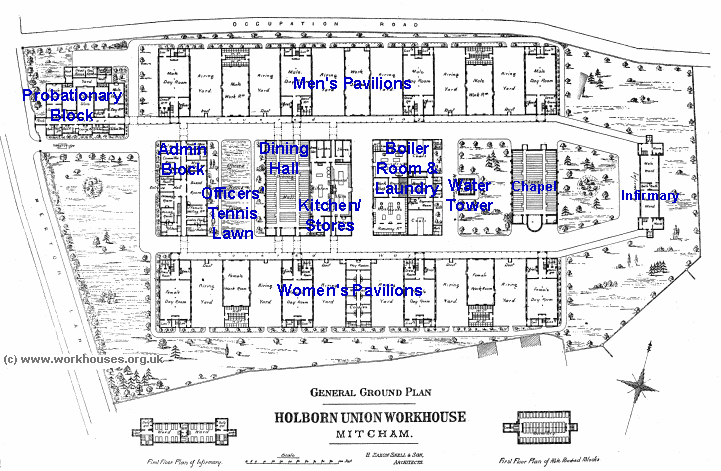
Holborn Mitchcham Plan, 1886
© Peter Higginbotham.
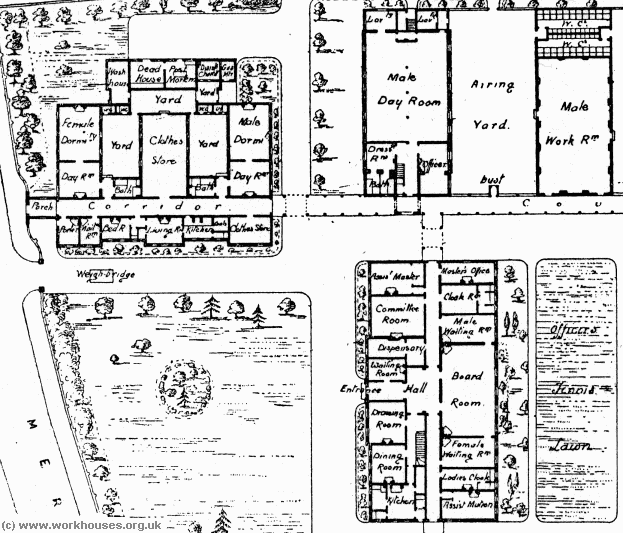
Holborn Mitchcham Plan (detail), 1886
© Peter Higginbotham.
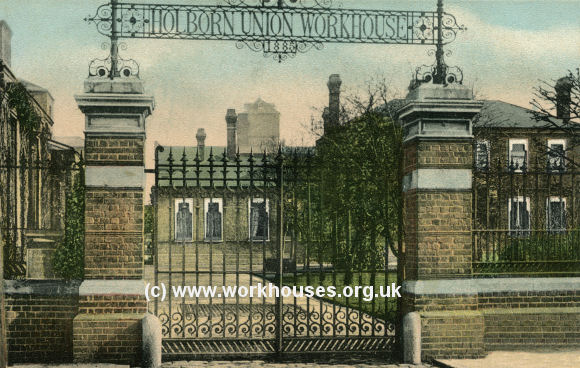
Holborn Mitcham workhouse entrance, c.1905
© Peter Higginbotham.
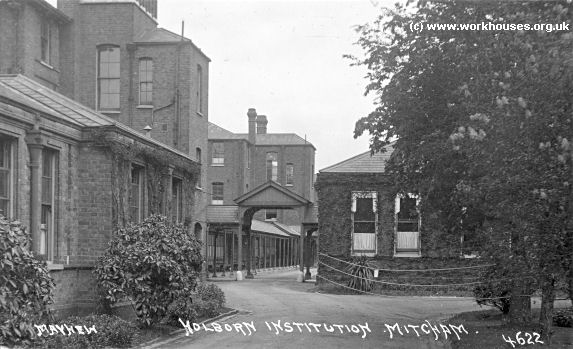
Holborn Mitcham workhouse probationary block (left) and admin
block (right) from the south-west
© Peter Higginbotham.
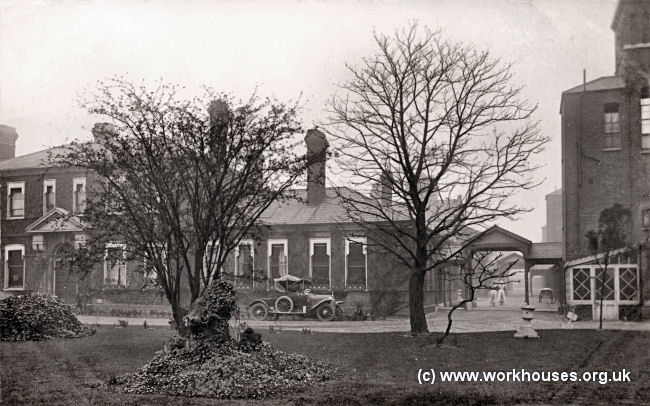
Holborn Mitcham workhouse admin block (left) and women's block
(right) from the south-west
© Peter Higginbotham.
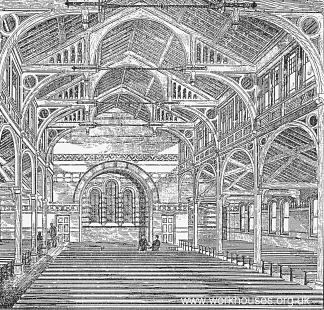
Holborn Mitcham workhouse dining hall interior, 1885
© Peter Higginbotham.
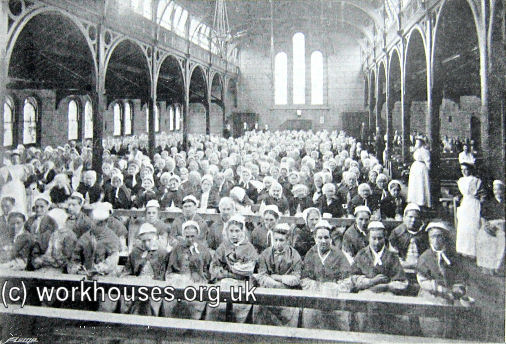
Holborn Mitcham workhouse old women dining, 1896.
© Peter Higginbotham.
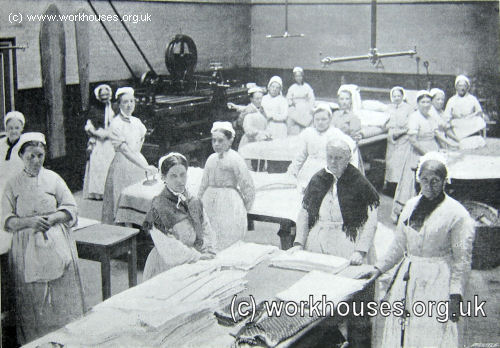
Holborn Mitcham workhouse laundry, 1896.
© Peter Higginbotham.
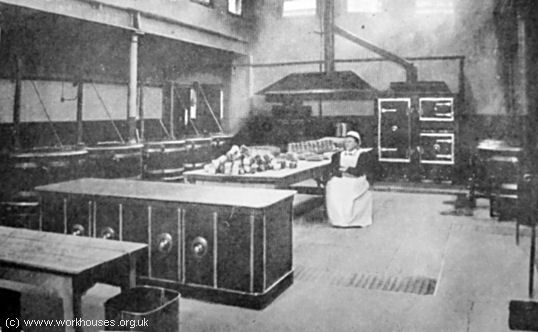
Holborn workhouse kitchens, c.1900.
© Peter Higginbotham.
In 1893, the Board of Guardians received report from a special committee that had investigated alleged defects in the construction of the new workhouse — the boundary wall had been erected without proper foundations; the wooden floors of the day and work-rooms had not been laid on the specified concrete and tar and were rotting; the chimney stacks had been constructed with inferior cement. The builder, who had been found to have committed similar misdemeanours elsewhere had already gone bankrupt, was agreed to be responsible, but the committee resolved that the architects were also guilty of negligence.
The work performed by inmates at Mitcham included corn-grinding, firewood chopping, tailoring, bricklaying, painting, plumbing, basket and mat-making. The workhouse also had its own farm a little way to the north of the main site. The farm site also incorporated a gas-works from which gas was supplied to the workhouse.
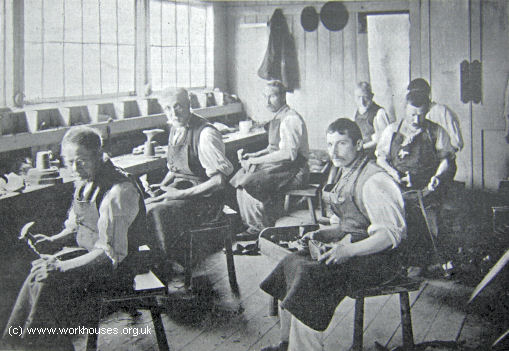
Holborn Mitcham workhouse shoemaking shop, 1896.
© Peter Higginbotham.
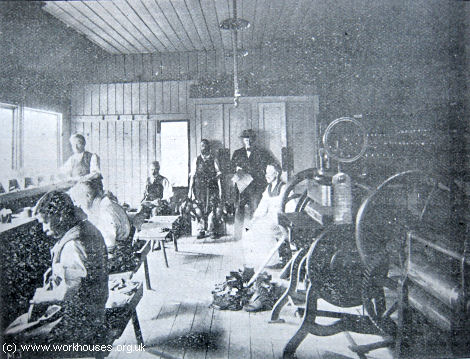
Holborn Mitcham workhouse shoemaking shop, c.1905.
© Peter Higginbotham.
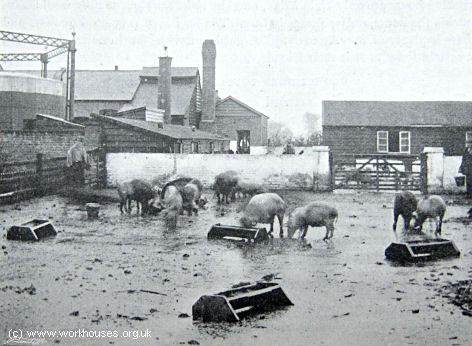
Holborn Mitcham farm and gas-works, 1896.
© Peter Higginbotham.
In 1914, the joint parishes of St Giles-in-the-Fields & St George, Bloomsbury, were added to Holborn Union. In 1915, the parishes of Clerkenwell, St Luke, St Sepulchre, Charterhouse, and Glasshouse Yard were merged to form the new civil parish of Finsbury. Finsbury remained part of the Holborn union.
During the First World War, the Mitcham workhouse was used as a military hospital for 954 'other ranks'. Following the end of the war in 1918, it was moth-balled pending a decision over its future fate. The workhouse infirmary on Short's Gardens that Holborn had inherited in 1914 from St Giles was also used as a First World War military hospital for 537 'other ranks'.
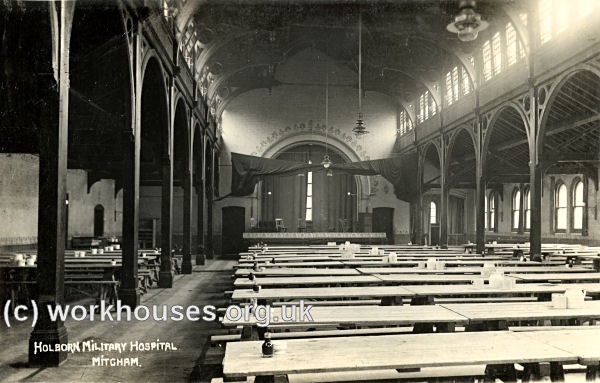
Holborn Mitcham workhouse dining hall interior, c.1915
© Peter Higginbotham.
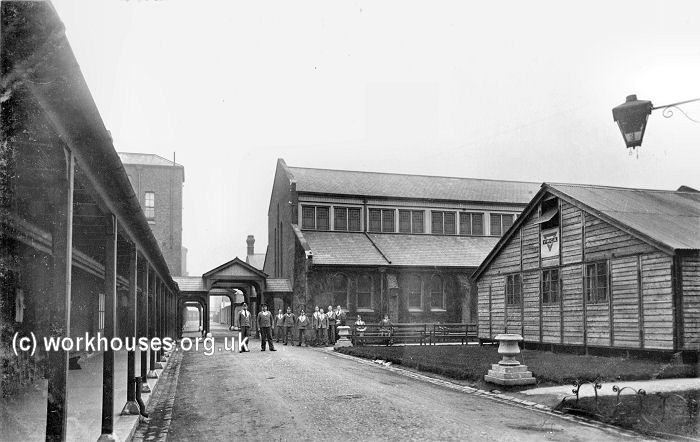
Holborn Mitcham workhouse from outside the probationary block, c.1915
© Peter Higginbotham.
Daphne Brown has kindly contributed (below) the memories of her mother Mary (née Rayner) who, together with her brother Jack (John) and sister Edith, lived in the workhouse in the in the early 1920s. Mary's parents, Nellie and Ernest, were live-in caretakers for the building from 1921-24.
Holborn Union Workhouse, MitchamThe SiteThe whole site was surrounded by a high (about 8ft) brick wall that was topped by cement and shards of broken glass. The entrance was by double gates outside the Lodge at the west end. There was a weighbridge near the entrance gates and a verandah (a covered walkway) running from west to east all along the south side of the male blocks. There were vegetable plots on the north side and an orchard on the south side. An iron fence ran from each front corner of the Epilepsy Block to the north and south perimeter walls with a gate on each side nearest the building. The Epilepsy Block had an iron spiral staircase on the exterior east wall. From there could be seen an orphanage with brick gate posts that had eagles on top. The eagle heads were knocked off sometime around the First World War because they were seen as a German symbol. The children went to Gorringe Park School. Mitcham fair could be seen from this staircase and lavender fields. Inside this block were two rooms with padded walls. The padding curved out from the wall and felt like foam to bounce on. The large lawn in front of the Master's House had yuccas and two large willow trees. The willow fronds were trained over a wide circular cage to form a leafy 'room'. There was a table/bench around the trunks of the trees. There were grass verges and gravel paths in front of the eight blocks and a croquet lawn behind the Master's house. Behind the masters house was an office/administration block The LodgeThe Lodge was a long building with a 12ft-wide mosaic tiled corridor running its length. Rooms led off each side. On the north side was a ward/dying-room leading on to the mortuary, and two fruit and vegetable store rooms with no windows and each having narrow shelves labelled, apples, pears, potatoes etc. The south side had an office (with the weighbridge machinery in it), a cleansing room, a receiving/clothing room, a kitchen and two dormitories The path to the mortuary led west from the main gates, through another set of double gates and turned north at the end of the Lodge. It was on the north wall of the front end of the Lodge. Three sides were outer walls and the fourth wall was attached to the north wall of the Lodge and held a door into the ward/dying room. The Master's HouseThis was a large double-fronted building with big flush windows (not bays) with wooden polished floors and a wide central staircase. At least two rooms had chandeliers and there were porcelain and metal handles that were pulled down in a curved slot in the wall, to summon the servants, in each room. There was a ground and first floor only. The ChurchThis was an empty building at this time but there was a stone font and pulpit and three pillars down each side of the aisle that had a wooden floor. There was no porch. Kitchens and LaundryHuge wooden trough sinks were in the laundry and an enormous copper that had fire grate under it. The kitchen and linen rooms had high wooden cupboards. The Prison BlockTwo cells, one on either side of the building, had large heavy metal doors, which clanged and locked when closed. There was a window in these doors. The Male and Female BlocksThe large residential blocks had stone floors and stone stairways between floors. There was no furniture. There were sash windows. During this time, Mary had tuberculosis and was put into the 'willow rooms' on a bed for many hours. She was only allowed into the mortuary, epilepsy block and the Master's house when accompanied by an adult, but had free run of the rest. She remembers the church well because she and Jack played at weddings, christenings and funerals in there. They also rode their bikes in and out of the pillars. Mary and Edith slept in the dying room next to the mortuary. Towards the end of the family's time there, some of the north-east blocks were used for industrial purposes. The first company to move in was Mitcham Lavender who made Lavender Furniture Cream. Next was a company making parchment lampshades and Mary's mother did out-work for them, sewing them up. |
The Mitcham workhouse buildings have now all been demolished and industrial units now stand on the site.
Lloyd Street Receiving Home
To deal with the initial processing of children coming into its care, The Holborn Union set up a Receiving Home for up to 25 children at 11 Lloyd Street, London WC1. After a probationary period at the home, which included a medical examination, children could be passed on to one of the union's other children's establishments.
Clerkenwell Road Offices and Dispensary
At the same time as the Mitcham workhouse was under construction, the union was erecting new offices and a dispensary at a site on Clerkenwell Road. The architects for the scheme were again Henry and Alfred Saxon Snell.
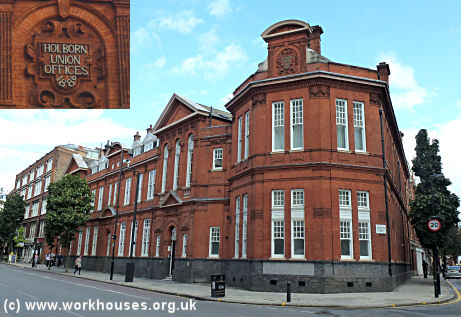
Former Holborn Union Offices and Dispensary, Clerkenwell Road, 2011.
© Peter Higginbotham.
Staff
Inmates
- Long-term workhouse inmates (1861)
- 1881 Census — Grays Inn Road Workhouse
- 1881 Census — Shepherdess Walk Workhouse
Records
Note: many repositories impose a closure period of up to 100 years for records identifying individuals. Before travelling a long distance, always check that the records you want to consult will be available.
The Ancestry UK- Ancestry: London Workhouse Admission/Discharges (1764-1930)
.
- London Poor Law and Board of Guardian Records (1738-1930)
.
- General records — Guardians' minutes (1836-1930); Committee minutes (1870-1930); Financial records (1848-1930); Staff records (1856-1930); etc.
- Grays Inn Road Workhouse — Admissions and discharges (1887-8, 1894, 1896); etc.
- Mitcham Workhouse — Admissions and discharges (1915-6); Creed registers (1886-98, 1902-16); etc.
- Mitcham School: Description of children admitted (1894-1913); School attendance register (1878-85); Register of children (1872-1932); Creed registers (1869-1932); Daily record of births (1901-27); Register of deaths (1889-1928); Register of deaths of infants under one year old (1876-1903); etc. [Earlier records listed under Southwark.]
Bibliography
- Higginbotham, Peter Workhouses of London and the South East (2019)
- The Builder, October 23, 1886
- The Times, October 23, 1886
Links
- None.
Unless otherwise indicated, this page () is copyright Peter Higginbotham. Contents may not be reproduced without permission.


